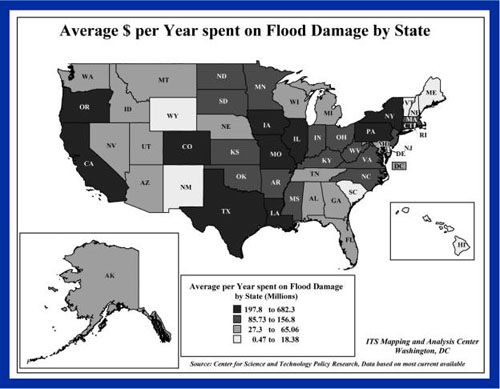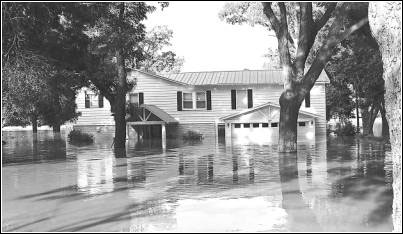Are You Ready?

Floods are one of the most common hazards in the United States. Flood effects can be local, impacting a neighborhood or community, or very large, affecting entire river basins and multiple states.
However, all floods are not alike. Some floods develop slowly, sometimes over a period of days. But flash floods can develop quickly, sometimes in just a few minutes and without any visible signs of rain. Flash floods often have a dangerous wall of roaring water that carries rocks, mud, and other debris and can sweep away most things in its path. Overland flooding occurs outside a defined river or stream, such as when a levee is breached, but still can be destructive. Flooding can also occur when a dam breaks, producing effects similar to flash floods.
Be aware of flood hazards no matter where you live, but especially if you live in a low-lying area, near water or downstream from a dam. Even very small streams, gullies, creeks, culverts, dry streambeds, or low-lying ground that appear harmless in dry weather can flood. Every state is at risk from this hazard.
What Would You Do?
You and your family moved from a city neighborhood in San Francisco, CA, to a suburb of Phoenix, AZ. Since earthquakes were a threat in your area, you always kept some extra food, water, and other supplies on hand and maintained an earthquake insurance policy, just in case something happened. You think this kind of preparation is no longer necessary based on what your neighbors have told you. According to them, the biggest threat they face is lack of water caused by the very dry weather. You continue to see public service announcements from the federal government about flood insurance and the need to protect yourself from flood damage. Surely, there would be no need for flood insurance where you live with its bare hills, deep canyons, and dry land.
Are you at risk for flooding, or is this more of a risk to people who live elsewhere? Yes or No
Is there a need to have a disaster plan and a disaster supplies? Yes or No
Should you consider purchasing flood insurance? Yes or No
Know the Terms
Familiarize yourself with these terms to help identify a flood hazard:
Flood Watch:
Flooding is possible. Tune in to NOAA Weather Radio, commercial radio, or television for information.
Flash Flood Watch:
Flash flooding is possible. Be prepared to move to higher ground; listen to NOAA Weather Radio, commercial radio, or television for information.
Flood Warning:
Flooding is occurring or will occur soon; if advised to evacuate, do so immediately.
Flash Flood Warning:
A flash flood is occurring; seek higher ground on foot immediately.
Take Protectice Measures
Before a Flood
To prepare for a flood, you should:
- Avoid building in a floodplain unless you elevate and reinforce your home.
- Elevate the furnace, water heater, and electric panel if susceptible to flooding.
- Install "check valves" in sewer traps to prevent flood water from backing up into the drains of your home.
- Construct barriers (levees, beams, floodwalls) to stop floodwater from entering the building.
- Seal walls in basements with waterproofing compounds to avoid seepage.
During a Flood
If a flood is likely in your area, you should:
- Listen to the radio or television for information.
- Be aware that flash flooding can occur. If there is any possibility of a flash flood, move immediately to higher ground. Do not wait for instructions to move.
- Be aware of streams, drainage channels, canyons, and other areas known to flood suddenly. Flash floods can occur in these areas with or without such typical warnings as rain clouds or heavy rain.
If you must prepare to evacuate, you should do the following:
- Secure your home. If you have time, bring in outdoor furniture. Move essential items to an upper floor.
- Turn off utilities at the main switches or valves if instructed to do so. Disconnect electrical appliances. Do not touch electrical equipment if you are wet or standing in water.

If you have to leave your home, remember these evacuation tips:
- Do not walk through moving water. Six inches of moving water can make you fall. If you have to walk in water, walk where the water is not moving. Use a stick to check the firmness of the ground in front of you.
- Do not drive into flooded areas. If floodwaters rise around your car, abandon the car and move to higher ground if you can do so safely. You and the vehicle can be quickly swept away.
Driving Flood Facts
The following are important points to remember when driving in flood conditions:
- Six inches of water will reach the bottom of most passenger cars causing loss of control and possible stalling.
- A foot of water will float many vehicles.
- Two feet of rushing water can carry away most vehicles including sport utility vehicles (SUVs) and pick-ups.
After a Flood
The following are guidelines for the period following a flood:
- Listen for news reports to learn whether the communitys water supply is safe to drink.
- Avoid floodwaters; water may be contaminated by oil, gasoline, or raw sewage. Water may also be electrically charged from underground or downed power lines.
- Avoid moving water.
- Be aware of areas where floodwaters have receded. Roads may have weakened and could collapse under the weight of a car.
- Stay away from downed power lines, and report them to the power company.
- Return home only when authorities indicate it is safe.
- Stay out of any building if it is surrounded by floodwaters.
- Use extreme caution when entering buildings; there may be hidden damage, particularly in foundations.
- Service damaged septic tanks, cesspools, pits, and leaching systems as soon as possible. Damaged sewage systems are serious health hazards.
- Clean and disinfect everything that got wet. Mud left from floodwater can contain sewage and chemicals.
Additional Information
Flood Insurance
Consider the following facts:
- Flood losses are not covered under homeowners insurance policies.
- FEMA manages the National Flood Insurance Program, which makes federally-backed flood insurance available in communities that agree to adopt and enforce floodplain management ordinances to reduce future flood damage.
- Flood insurance is available in most communities through insurance agents.
- There is a 30-day waiting period before flood insurance goes into effect, so don't delay.
- Flood insurance is available whether the building is in or out of the identified flood-prone area.
 Print
Print Email
Email







